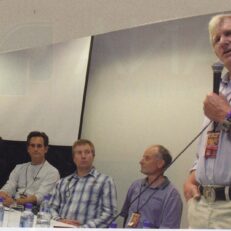The recent Equitana Asia Pacific 2003 Expo in Melbourne was certainly an experience for me as an educator. The obvious benefit of this four day trade expo for horse enthusiasts is to observe all manner of people demonstrating everything to do with horses under one roof and to be able to collate and compare information, and to dream and fantasize.
The spectators, including me, watched the wonderful working stockhorse demonstrations, while the tireless repertoires from Steve Brady and Guy McLean really did strengthen the resolve to try and improve.
My own mission at Equitana was to demonstrate ‘Shoeing for Performance’ and to promote a greater understanding of the importance of correct hoof care. The day before my first session I went to the stables and the competition areas to look at the horses who were here for this top class expo of excellence; they were all scrubbed and polished within an inch of their lives in anticipation, but sadly at least sixty percent were having trouble just standing on their badly prepared (or unprepared) feet, let alone being capable of performing and competing in heavy sand arenas. It seems that so many horse owners, riders and trainers are still unaware of their duty of care when it involves their horses’ feet and are also unaware of the detrimental effect that badly prepared hooves have on performance. I know I carp on this theme continually, but to achieve top performance results, or even just to own a horse, hoof care MUST rank at the same level as the care and preparation of the horse.
There were educators promoting the benefits of horses going barefoot and others showing the virtues of strap on boots and stick on rim strips, all suggested as desirable alternatives to the supposed horrors of conventional shoeing. I watched them all as they spoke of hoof restriction, concussion, thrush, white line disease and moisture content etc, but not one of these educators mentioned hoof balance or how to achieve it even though they had the perfect opportunity to do so because the horses on which they were demonstrating had overgrown hooves! Without actually demonstrating anything, other than showing a cadaver hoof model to the crowd, the barefoot expert stated unequivocally that a horse can perform better without shoes but did not even attempt to trim the overgrown hoof of the live horse supplied for his demonstration.
My first demonstration was on the same coloured gelding, who was standing splayed in front and cow hocked behind, so I was able to show the audience how to measure back from the frog to see exactly how to correctly trim and balance the front hooves, then to select and fit as light a shoe as possible to enhance the horse’s performance. Session time did not permit me to do his hinds but I explained to the audience that this horse was suffering acute back pain which would only be relieved once his hind hooves were trimmed and balanced correctly at my next session the following day.
Before my next session, the same horse was then used by three other demonstrators for veterinary chiropractic, barefoot trimming and saddle fitting, none of whom made any reference to his cow hocked stance behind or his obvious discomfort even though he was continually shifting his weight behind. It was a great example of their inability to read horse body language. It was a huge relief for me and for Toby at my next session when I balanced and shod his hinds, and alleviated the pressure. It is upsetting to see an animal in pain, and I find it amazing that supposed horse lovers cannot recognise suffering in an animal.
Barefoot trimming is the latest trend, where the proponents maintain that all horses should go barefoot. However, consideration MUST be given to the breed of horse, the condition of the hoof, the health of the horse, the comparison between the terrain of the competition and the stabling at home. And if the horse is crippled from poor and unbalanced shoeing, can someone please tell me how the same farrier will miraculously be able to trim the same horse so that it is balanced? Regardless of whether it is shod or left barefoot, any horse MUST first be trimmed correctly.
At Equitana, I was asked several times about using square toed shoes – my answer is always the same: I will use a square toed shoe when I find a horse with a square coronary band. Shoeing is a simple task, and when the hoof is balanced correctly, the horse will move correctly and perform correctly. All these new inventions are, unfortunately, a bandaid to get around the ever increasing problem of poor shoeing and lack of knowledge by the farrier.
I participated in a debating session on ‘To Shoe Or Not To Shoe’, which was packed with horse owners, all desperate for knowledge. Judging from the avalanche of enquiries I received during the four days at Equitana, these owners are desperate for knowledge to resolve the problems with their horse’s feet. Unfortunately, there were very few farriers at Equitana, and until those farriers are prepared to acknowledge that they can learn more, these problems will continue, regardless of whether the horse is barefoot or shod.



